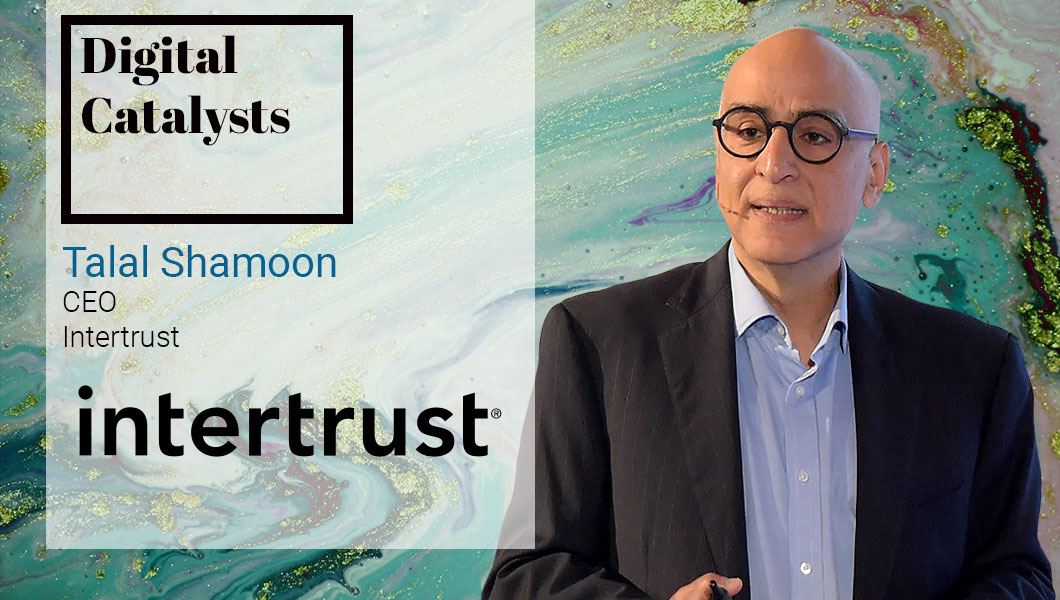Interview with Soumyasanto Sen, Co-Founder & Partner at People Conscience

Soumyasanto Sen, Co-Founder & Partner at People Conscience, provides mentorship and coaching to start-ups and entrepreneurs. As a blogger, advisor and speaker for HR technologies, he aims to spread the word about use of technologies in the people cause for digital transformation. Striving for a better future and collaborating with corporates in leading and adopting a digital mindset with strategic cultural change, Soumyasanto, the evangelist for the Future of Work, is currently engaging in AI-driven analytics, cultural analytics, blockchain, gig economy for people-centric businesses and digital HR transformations. With over 13 years of experience in ERP, UX, innovation, management advisory with big consulting houses, he insists investing in HR tech is not the same as digital transformation. Here, Soumyasanto speaks on issues of how to integrate technology across the business, what digital transformation requires, and why digital goes beyond technology
Most organizational leaders feel overwhelmed by technology, and they’re not sure where to begin or how much money and time to spend on digital transformation. While digitalization is an essential part of a corporate strategy, for business owners and HR professionals, digitalization is just a buzzword. So, what does a digital transformation of the workplace mean for an organization?
Digitalization can extend the reach of organizations, improve management decisions, and speed the development of new products and services. At the same time, the excessively rapid adoption of technologies can disrupt traditional business models. Business owners are equally responsible for successful digital transformation.
The challenge of digitalization is not acquiring a proficiency in digital technologies. Instead, management must create the conditions and culture needed to enable a transformation to a digitally mature organization.
Leaders and HR professionals must also help people (customers, suppliers, employees) take on the right mindset for adopting all these changes. The real value of digital transformation for HR is that it enables the whole organization to think creatively.
So, for me, digitalization is more than a buzzword, and it is an essential part of corporate strategies, for sure. There is no alternative to digital transformation. Visionary companies will carve out new strategic options for themselves – those that don’t adapt, will fail.
The digital workplace is also considered a company asset. The digital workplace encompasses all the technologies people use to get work done in today’s workplace. It ranges from HR and core business applications to e-mail, instant messaging, enterprise social media tools, and virtual meeting tools.
As per Deloitte, the digital workplace framework consists of four layers, covering the following components, shown in the diagram below:
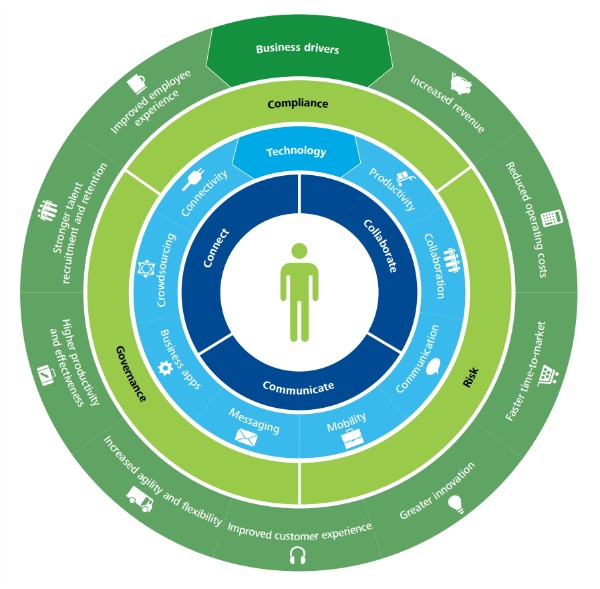
According to Deloitte, the digital workplace is all about the employees’ ability to do their job by collaborating, communicating, and connecting with others.
Technology enables the digital workplace. Each organization already has a digital workplace toolbox with different tools. Depending on your industry and business needs, the tools needed to support your digital workplace vary. The key is to adopt the right tools for your employees to do their jobs.
An effective use of technology in the digital workplace is underpinned by appropriate controls. This means one must support the digital workplace with appropriate governance structures and management processes.
As with any core initiative, it is essential for business needs to drive the digital workplace. To deliver the necessary benefits, the direction of your organization should guide the direction of your digital workplace.
What stages does digital transformation consist of? What steps are the most important and require particularly close attention? What about HR digital strategies? Does it need a great change in mindset?
To be very clear, investing in technology is not the same as digital transformation. Most companies are now investing in new tools, applications, platforms, and services. These make them tech-enabled, but it doesn’t mean companies are actually transforming in a digital economy. With digital transformation, technology is driven by purpose, and that purpose is meant to reshape business.
Based on the research of companies like Cognizant and Altimeter, there are six key stages many organizations go through in their digital transformation. But, this doesn’t mean everyone has to follow this sequence.
Six Stages Digital Transformation
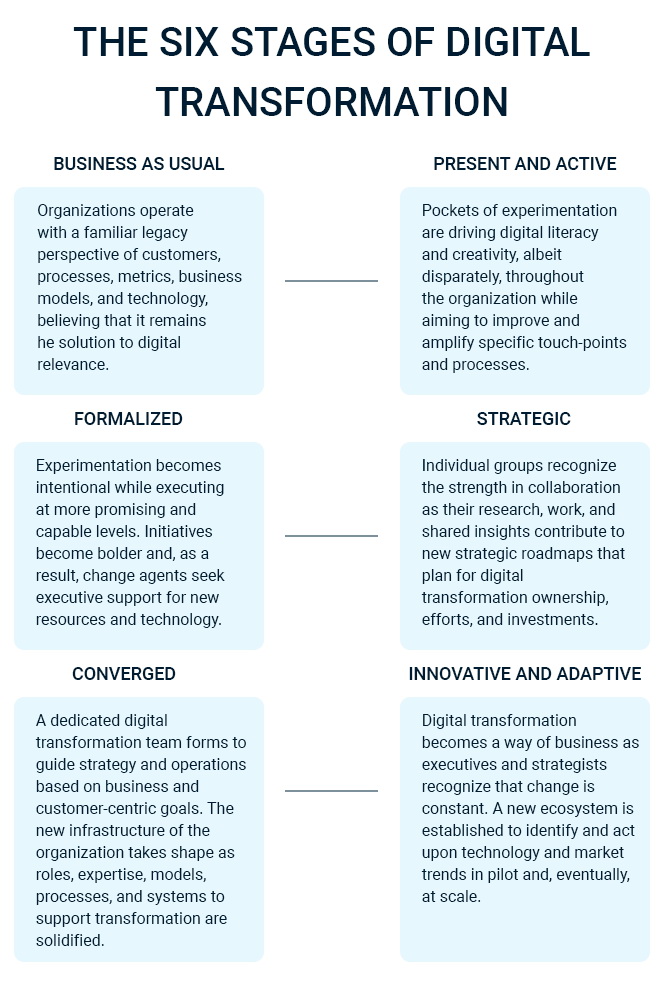
Digital transformation enables people to think and to transform. Digital transformation is about the ability of the organization, and therefore people’s minds not only to adapt to change, but to drive change and innovation, enabling the organization to deep dive into its need, values, purpose and mission.
Digital transformation is not just bright new technology – it’s a new way of organizing, engaging with customers and employees, and building networks of expertise and trust – through cooperation and collaboration – and working faster, better, smarter than ever before.
In a world where gig workers already make up 40% of the #workforce, the #blockchain platform like @TiiQu_Network will be important for #HR to get paid through #smartcontracts >> Blockchain could make a huge impact on #gigeconomy & future #Workforce. Good to see TiiQu @degiolaura https://t.co/gjuOFM7U1g
— Soumyasanto Sen (@soumyasanto) April 6, 2018
Embracing the digital world and implementing technological transformations don’t necessarily begin with technology. They actually begin with a profound change in mindset, an evolution in the way we see the world. Digital strategy plays an important role here.
HR digital strategies or HR technology strategies should actually support the overall strategic objectives of the organization, and HR must take ownership of the digital strategy and ensure that it aligns with the HR strategy, which in turn should align with the business strategy. Moreover, it should emphasize more than just efficiency and effectiveness as a driver for the adoption of technology, and choose solutions that allow for future growth and flexibility, while focusing on deploying solutions that meet the current and future needs of the organization.
Drivers that can lead digital strategies for HR are:
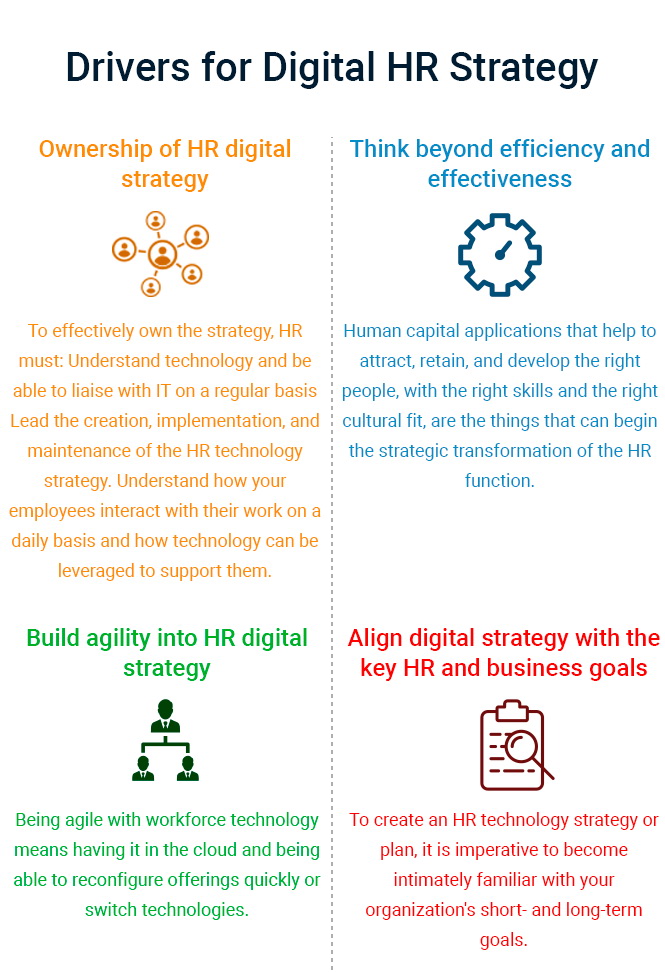
It is a common practice to identify the benefits of new HR technology before the implementation process begins. But what benefits should be included in this list? And, what are some of the common benefits that you have seen companies look for from new HR technology?
By selecting the right technology, HR departments and professionals can deliver simpler, faster and smarter user interfaces, as part of an HCM system. This allows organizations to put productivity and engagement at the heart of the process, which in turn should encourage employee loyalty.
The major investments in HR technology solutions are time, money, and energy. One must include the following benefits when considering HR technology transformation:
- Easy administration and sharing of information
Good HR technology allows information, whether written or broadcast, to be shared more quickly and with fewer resources. It should also provide easy administration that eliminates the need for double or triple entry systems and reduces the need to file large amounts of paperwork. - Greater productivity
A better HR system can produce real productivity benefits, as the adoption of innovative tools leads to workforce optimization, competitive advantage, and greater customer satisfaction. Productivity is essential to the employees, employers, the organization, and the economy, as they will all benefit from this. - Reduced cost
Aside from the less tangible costs such as efficiency or productivity, good HR technology will save real money; especially in the era of cloud computing, cost reduction is considered one of the main benefits of any HR technology. - Improved communication
HR technologies must provide employees the opportunity to do their job by collaborating, communicating, and connecting with others, increasing employee engagement and improving performance in turn. - Focus on analytics
Analytics is no longer about finding interesting information and identify it for managers. Now, data is being used to understand every part of a business operation, and analytical tools are being embedded into the day-to-day decision-making of business operations. HR analytics plays a vital role here.
There are many other benefits, and aside from the convenience of a HR system that is accessible online by employees and managers, these include:
- Going mobile for continuous accessibility
- Helping with consistency
- Ensuring compliance and privacy
- Improving user experience
How long does the tech implementation process last for companies? And, does it vary for various verticals? Is it fair to say that the digitalization of workflows is a never-ending process?
Digital transformation isn’t an outcome; it’s a complex but developing journey. I don’t think that anyone today can claim they have reached the end of the digital transformation process. Most are just beginning; in fact, some of them haven’t even started yet.
According to MIT / Sloan research, 63% of executives revealed that the pace of technology change in their organization was too slow. In the same report, the most frequently cited obstacle to digital transformation was “a lack of urgency.”
Henry Ford had said, “If I had asked people what they wanted, they would have said ‘faster horses.” So, in this digital era, one cannot give a fixed timeline, as it’s a continuous improvement process. Digital transformation is big and also costly. It covers everything from effectively engaging customers, vendors, and employees, forming new teams to collaborate, forcing process improvements and innovation, optimizing business models, and inspiring new infrastructures, etc.
It’s actually an agile process, which is, of course, never-ending if we think so. The process involves measuring, learning, and building continuously throughout the journey.
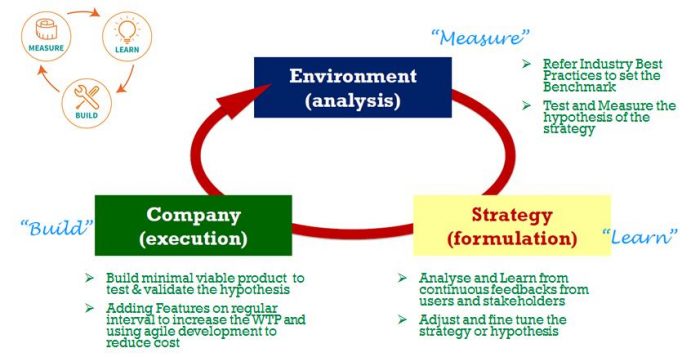
Why do you think so many implementations of new HR technology, which costs tens of thousands, fail?
Organizations are using hundreds, sometimes thousands of applications. New applications are constantly being deployed, whether the new version are upgrades or replacements for old legacy applications. This all brings risk, and if this is not taken into account, they fail. The most important issues as of today are:
- Adoption is the key to the success of products and services.
The most important point is to accept the change and adapt to the transformation. If the users don’t like to use the application or start diminishing, all your efforts will come to an unfortunate end. - User experience matters the most today.
Today, users’ expectations are very high. In their personal lives, they’re used to having easy-to-learn and easy-to-use technologies at their fingertips.
A top-notch user experience is a great way to keep users involved and engaged with a product in this digital age.
Besides this, no organization can ignore the reasons for an unsuccessful transformation as listed below:
- Unengaged stakeholders or owners
Any successful HR technology project requires the active engagement of the right stakeholders – the decision-makers and owners of the business processes involved in the problem being addressed, who can make the right decisions and lead the project to success. If they are missing or unengaged, the chances of failure become very high. - Lack of relevance to the business
A very common reason for failure is a lack of relevance to the business. It is not unusual for any HR technology project to focus on a topic or area that doesn’t actually add value to the business. Value addition is very important for any business, especially when you are considering transformation. - No measures or agility
No enterprise business can manage or improve until it can measure. So, measure and benchmark the business’ existing user experience and instantly compare any variations when a change is made. There is always scope for improvement, and the process must be agile.
Others reasons also include:
- Lack of highly skilled teams
- Lack of integration of new and existing technologies and data
- Slow and poor processes
- Outdated technologies
- Lack of collaboration between IT and business
The reasons may vary for each company, but these are the most significant reasons that are common behind transformation failures.
There is an opinion that only HR personnel should work in HR. Does a company need to bring technical people or HR personnel with tech skills into its HR department before starting the process of digital transformation?
The team is the ultimate productivity structure within any organization and HR needs to be right in the middle of this, ensuring the right personalities and skills are represented, and driving new methodologies to ensure the best possible consequences. Increasing team engagement and diversity, using psychometric assessments, encouraging continuous performance feedback, and ensuring trust and collaboration are the major challenges for any team development.
According to Bersin, if HR isn’t supporting the building, optimization, performance, reward and recognition, and methodological support elements, the entire project could be at risk of failing miserably.
So in respect to the strategy, to compete successfully in the new digital economy, HR should:
- Use technology effectively to execute business imperatives and extend collaboration with other departments, incorporating mobile technology, analytics, social media, and the cloud to ease the transition to a strategic role.
- Consider the competitive risk of not leveraging technology to contribute to business strategy. Organizations in developed economies are not adopting technology as quickly as their peers in fast-growing economies and may risk being left behind in the global competition for talent.
- Embrace the transition to strategic thinking and driving business results.
Digital transformation cannot progress smoothly without the integration of IT and business. Most of the successful digital transformation projects involve HR and technology people together within one team. Lack of collaboration between them leads to failure for sure.
This interview was originally published here.


 By
By 
